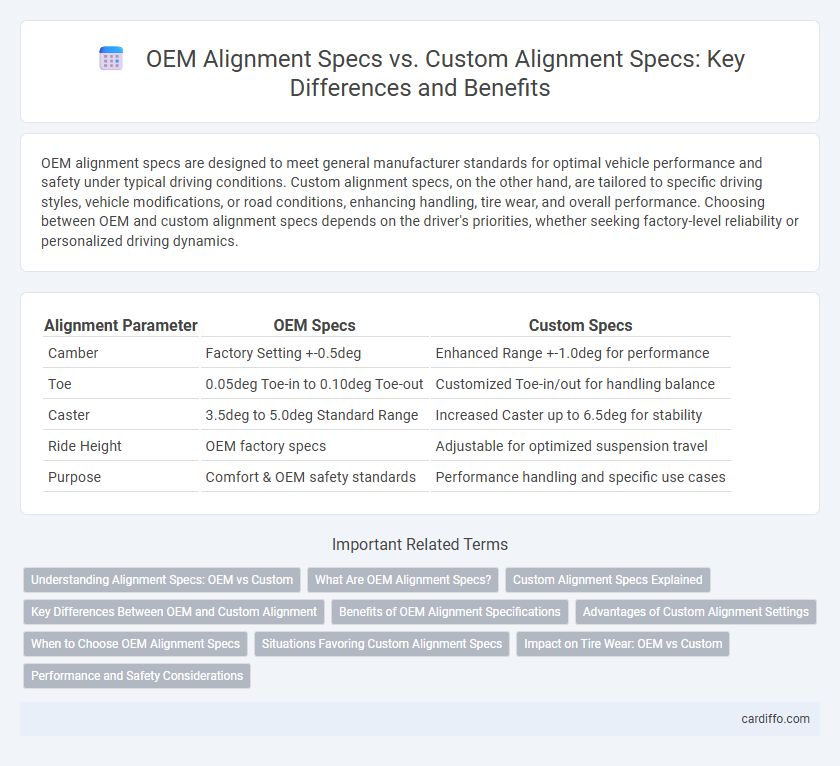OEM alignment specs are designed to meet general manufacturer standards for optimal vehicle performance and safety under typical driving conditions. Custom alignment specs, on the other hand, are tailored to specific driving styles, vehicle modifications, or road conditions, enhancing handling, tire wear, and overall performance. Choosing between OEM and custom alignment specs depends on the driver's priorities, whether seeking factory-level reliability or personalized driving dynamics.
Table of Comparison
| Alignment Parameter | OEM Specs | Custom Specs |
|---|---|---|
| Camber | Factory Setting +-0.5deg | Enhanced Range +-1.0deg for performance |
| Toe | 0.05deg Toe-in to 0.10deg Toe-out | Customized Toe-in/out for handling balance |
| Caster | 3.5deg to 5.0deg Standard Range | Increased Caster up to 6.5deg for stability |
| Ride Height | OEM factory specs | Adjustable for optimized suspension travel |
| Purpose | Comfort & OEM safety standards | Performance handling and specific use cases |
Understanding Alignment Specs: OEM vs Custom
OEM alignment specs are designed by vehicle manufacturers to balance ride comfort, tire wear, and handling under typical driving conditions using standardized measurements. Custom alignment specs are tailored to individual driving styles, performance goals, or specific vehicle modifications, allowing adjustments to camber, caster, and toe beyond factory parameters. Understanding the differences between OEM and custom specs helps optimize vehicle performance and tire longevity based on specific needs and usage.
What Are OEM Alignment Specs?
OEM alignment specs are the vehicle manufacturer's original specifications established for wheel alignment angles such as camber, caster, and toe. These specs ensure optimal handling, tire wear, and safety, reflecting the design parameters tested during vehicle production. Following OEM alignment specs helps maintain the intended driving dynamics and prolongs tire life compared to custom alignments, which adjust settings beyond factory recommendations for specific driving styles or conditions.
Custom Alignment Specs Explained
Custom alignment specs prioritize individual driving habits, vehicle modifications, and road conditions, offering a tailored approach beyond the generic OEM alignment standards. This method adjusts camber, caster, and toe angles to optimize performance, tire wear, and handling for specific use cases such as racing, off-roading, or heavy-load driving. Data-driven alignment tools and advanced diagnostics ensure precision, enhancing vehicle safety and longevity by aligning suspension settings with real-world driving dynamics.
Key Differences Between OEM and Custom Alignment
OEM alignment specs are manufacturer-recommended settings designed to optimize vehicle performance, safety, and tire wear based on standardized testing. Custom alignment specs, tailored to specific driving conditions or performance goals, deviate from OEM guidelines to enhance handling, accommodate modifications, or correct uneven tire wear. Key differences include the range of camber, caster, and toe adjustments, where custom specs often allow more aggressive settings for improved cornering or load handling compared to OEM's balanced approach.
Benefits of OEM Alignment Specifications
OEM alignment specifications ensure optimal vehicle performance by adhering to manufacturer-tuned parameters, preserving ride comfort, handling stability, and tire longevity. These factory-set specs are rigorously tested for safety and efficiency across various driving conditions, offering reliability unmatched by custom alignments. Maintaining OEM specs supports warranty compliance and enhances resale value by demonstrating adherence to original engineering standards.
Advantages of Custom Alignment Settings
Custom alignment settings offer tailored adjustments that precisely match a vehicle's suspension geometry and driving conditions, enhancing handling performance and tire longevity. Unlike OEM alignment specs, which are standardized for mass production, custom specs optimize camber, caster, and toe for improved traction, cornering stability, and reduced tire wear. This personalized approach ensures superior vehicle dynamics, especially in performance and off-road applications.
When to Choose OEM Alignment Specs
OEM alignment specs ensure optimal vehicle performance by adhering to manufacturer-standard parameters tailored to each make and model. Choose OEM alignment specs when aiming to maintain factory handling characteristics, tire wear patterns, and warranty compliance. Custom alignment specs are better suited for performance enhancements or specific driving conditions that deviate from standard factory settings.
Situations Favoring Custom Alignment Specs
Custom alignment specs are ideal for vehicles subjected to unique driving conditions like off-road use, motorsports, or heavy towing, where OEM specifications may not provide optimal performance or tire wear. Custom specs allow adjustments tailored to specific handling preferences, suspension modifications, and load requirements, enhancing vehicle stability and traction. These personalized alignments improve overall drivability and safety by addressing factors beyond standard factory tolerances.
Impact on Tire Wear: OEM vs Custom
OEM alignment specs are designed to meet manufacturer standards, ensuring balanced tire wear and optimal vehicle handling under typical driving conditions. Custom alignment specs adjust camber, toe, and caster based on specific vehicle usage or performance goals, which can lead to uneven tire wear if not properly managed. Understanding the differences between OEM and custom alignment settings is crucial to minimizing premature tire wear and maintaining vehicle safety.
Performance and Safety Considerations
OEM alignment specs provide manufacturer-recommended settings optimized for safety, ride comfort, and predictable vehicle handling under standard conditions, ensuring compliance with warranty and regulatory requirements. Custom alignment specs prioritize enhanced performance tailored to specific driving styles or track conditions, often optimizing camber, caster, and toe angles to improve grip, responsiveness, and cornering stability. While custom settings can elevate driving dynamics, they may compromise tire wear and safety margins if not carefully calibrated within tolerances close to OEM specifications.
OEM Alignment Specs vs Custom Alignment Specs Infographic

 cardiffo.com
cardiffo.com